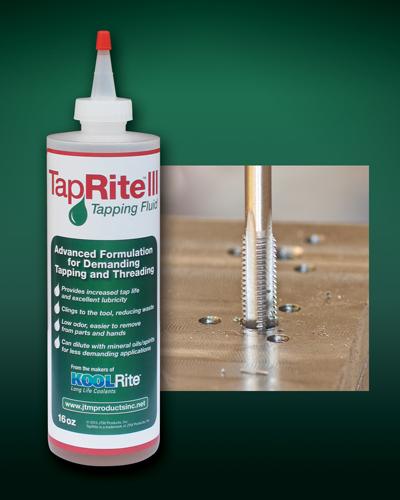
A new high performance tapping fluid has been announced by its manufacturer, JTM Products Inc. TapRite III Tapping Fluid features an advanced formulation for demanding tapping and threading applications in ferrous metals. It provides increased tap life and excellent lubricity in steel alloys and other severe uses as well as mild steels.
TapRite III fluid is a chlorinated oil/wax gel concentrate. It clings to the tap to reduce waste, but is easier to remove from parts and hands than other widely-used tapping fluids. It can be used straight or can be diluted with mineral oil or spirits for less demanding applications. TapRite III is an ideal replacement for the popular Moly-DEE tapping fluid, which has been discontinued by its manufacturer.
TapRite III fluid is available in 16 oz. bottles as well as 1 gallon and 5 gallon pails.
Contact Details
Related Glossary Terms
- alloys
alloys
Substances having metallic properties and being composed of two or more chemical elements of which at least one is a metal.
- lubricity
lubricity
Measure of the relative efficiency with which a cutting fluid or lubricant reduces friction between surfaces.
- tap
tap
Cylindrical tool that cuts internal threads and has flutes to remove chips and carry tapping fluid to the point of cut. Normally used on a drill press or tapping machine but also may be operated manually. See tapping.
- tapping
tapping
Machining operation in which a tap, with teeth on its periphery, cuts internal threads in a predrilled hole having a smaller diameter than the tap diameter. Threads are formed by a combined rotary and axial-relative motion between tap and workpiece. See tap.
- threading
threading
Process of both external (e.g., thread milling) and internal (e.g., tapping, thread milling) cutting, turning and rolling of threads into particular material. Standardized specifications are available to determine the desired results of the threading process. Numerous thread-series designations are written for specific applications. Threading often is performed on a lathe. Specifications such as thread height are critical in determining the strength of the threads. The material used is taken into consideration in determining the expected results of any particular application for that threaded piece. In external threading, a calculated depth is required as well as a particular angle to the cut. To perform internal threading, the exact diameter to bore the hole is critical before threading. The threads are distinguished from one another by the amount of tolerance and/or allowance that is specified. See turning.
